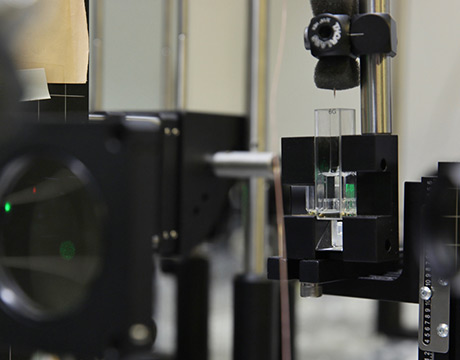www.asme.org: Anyone who’s watched a 3D printer in action knows the whole experience is one of excruciating boredom. It can take hours for a standard a standard printer to create a simple figurine. Yawn.
Maxim Shusteff, a staff engineer in the materials engineering division of the Lawrence Livermore National Laboratory, and his colleagues, were just as bored with the process as the rest of us. So they found a way to speed things up…by a lot.

4 comments:
This is just sci-fi. Shooting a laser into a liquid polymer to solidify it: how often have we seen something like that in some movie. This is incredible. It’s also intersting that they can only make things that are clear, though that is the logical first step. I thought it would have stopped there, or they would have had to use different colored polymers and the same lasers so the transparent plastic has a color tint to it, but apparently that’s not the solution. According to the article, “Transparency is not as narrow of a category as, intuitively, we think it is” meaning they can use lasers of different light waves and get different colors and transparencies. Which just blows my mind. And the print time is seconds long because it solidifies everything at the same time. I really wish they included a video of this happening or pictures of the finished product, because I am now so about this new 3D printer. I wonder if you can still do rotating parts and parts within parts like you can with a normal printer, which I think you can since the lasers just hit exactly where you want it to.
I never really thought that the part of 3D printing that slows everything down is the dry time. 3D printing is a tad bit debilitating slow. There is a lot you can do with it if it were faster. Lets say there is a bracket I need and I need it now, I can model it quick, but then might have to wait 5 hours to print it. At that rate I might as well figure something else out. Lets say, carve it, build it up, anything that wouldn’t take forever. So long as structure isn’t sacrificed, which I don’t think it is, a faster 3d printer would be quite an improvement. If there is a piece you know you need, like a prop, sure, 3D printing is great, you start it and when you come in the next morning its done. However, if you don’t have the luxury of time 3D printing might not be so useful…until now.
I don't know what this author is talking about, I find watching the 3D printer do it's thing is relaxing and peaceful. Especially since the printer is warm and you can lean up to it. PTM is cold, you gotta find a heat source somewhere in the building. But, more realistically, if I was running my own 3D printing business, I would look for ways to speed up my printers in order to produce more products. It's really cool that these new printers cure the material instantly, which makes me think that they then don't have to go into the acid bath to break down the support. That saves a ton of time, especially since soaking your piece can take ten plus hours in order to break it all down. To have a material that instantly cures completely gets rid of the acid soaking step, which speeds up the process immensely.
Oh 3D printing, this article talks about a process that has been around for quite some time now. The method of printing from a vat of polymer and using a laser to harden it has been around for quite some time and is continually gaining ground over the traditional methods of 3D printing. It is a method that I haven't had much experience with but far prefer it over printing with two parts then having to remove one later. It both helps to save steps and thus dramatically increases time because once it's done, it's done! There are many volumetric printers out on the market today, and it is only going to keep growing. This does make it harder though when one thinks about the size of the thing, you are wanting to print and thus are limited by tank size. Currently, the largest tanks I have found were about 18" and therefore great for some things but not in the large format we want yet.
Post a Comment